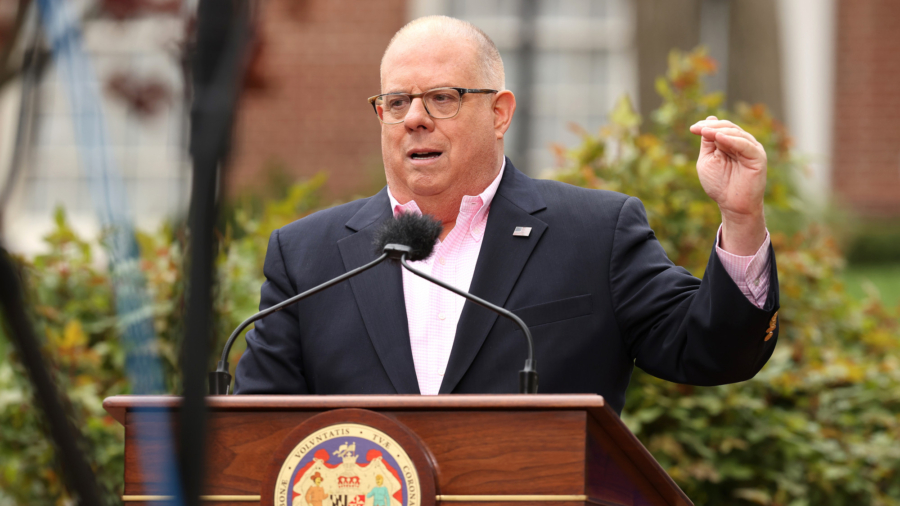Governors from across the nation defended plans to reopen their states in televised appearances on April 26 as signs continue to emerge of a pandemic on the decline.
Maryland Gov. Larry Hogan, a Republican, introduced on April 25, a road map for the state’s reopening. While the numbers of new cases and deaths remain high, total hospitalizations remain flat over the past week. Hogan plans to begin a phased, data-driven reopening in early May.
“We’re watching certain metrics and looking at a pattern of numbers before we make any kind of decisions. Everything is going to be based on the numbers and the science. We’re not going to do anything that’s going to put anybody in more danger,” Hogan told ABC News’ “This Week.”
“I want to get our economy back opened just as soon as we can, but I want to do so in a safe way, so we don’t have a spike; we don’t cause more deaths and overloading of our health care system.”
Hogan said that the National Governors Association, which he chairs, issued reopening guidelines to governors on April 22. Asked if he thought some governors are moving to reopen too soon, Hogan declined to second-guess his colleagues.
“The president made it clear that the governors were going to be making their own decisions based on the facts on the ground in their own states, and that’s exactly what they are doing,” Hogan said. “Various governors are making decisions based on what they think is best for their state.”
Governors from coast to coast are dealing with a choice between continuing the damage to the economy brought by prolonged shutdowns or risking a second wave of infections by reopening too soon.
State economies have been hit in varying degrees by the outbreak of the CCP virus, (Chinese Communist Party virus) commonly known as the novel coronavirus. Hogan said there’s bipartisan consensus that the taxpayer money from the federal government should be used to help states fight and recover from the pandemic.
More than 963,000 cases were confirmed in the United States as of April 26, according to data from Johns Hopkins University.
Although outbreaks are still appearing throughout the nation, in the past week, 46 states reported a decline in COVID-19 hospitalizations, according to the White House, and 23 states reported declines in new cases.
Michigan Gov. Gretchen Whitmer, who enacted some of the most aggressive stay-at-home measures in the country, defended her decision and echoed Hogan’s call for a measured approach to reopening. Whitmer, a Democrat, extended Michigan’s stay-at-home order until May 15 while easing restrictions on some activities such as boating and golfing. The number of daily new COVID-19 cases in Michigan peaked in early April. Whitmer has not outlined specific plans for reopening.
“We’ve gotta be nimble, and we have to follow the science and be really smart about how we reengage, because no one, even if you’re a protester or the sitting governor or you’re on another side of the issue, we know that no one wants a second wave, it would be devastating for the health of our people and for the economy,” Whitmer told “This Week.”
In New Jersey, the situation on the ground suggested that the state may be weeks away from a phased reopening, according to Gov. Phil Murphy, a Democrat. The state is the second-hardest hit by the pandemic, with more than 109,000 confirmed cases and 5,938 deaths. While fatalities remain high, there are signs of improvement: the number of daily new cases has flattened, COVID-19 hospitalizations are beginning to decline, and the use of ventilators and intensive care units is “down a little bit,” Murphy told NBC’s “Meet the Press.”
“Those are good signs, but we’re not out of the woods yet. I think we’re several weeks away,” Murphy said. “The mandate to stay at home and stay away from each other is still very much in effect until we can break the back of this curve.”
During the early stages of the CCP virus outbreak, Murphy split New Jersey into three regions to help the health care system respond to different realities in different locales. The counties in the metropolitan New York region have been hit hardest, but the state now has confirmed cases and deaths in every county.
Asked if his approach to reopening would revolve around the regional approach, Murphy said, “We’re going to move as one state, recognizing you’ve got density issues in the north that you just don’t have in the south.”
In Colorado, Gov. Jared Polis has already granted relief from a stay-at-home order to one county. He is also allowing business offices to reopen on May 4 with a reduced workforce. Polis, a Democrat, nonetheless believes that the state will have to have some sort of social distancing measures for months.
Asked if he would reissue the stay-at-home order if the reopening of the offices causes a spike in new infections, Polis said the state might adjust the guidelines based on the data.
“We will have to adjust, and we expect that we’ll have to adjust the degree of social distancing in real-time,” Polis said to “Meet the Press.”
Polis suggested that the gradual easing of the social distancing rules is necessary to address the pandemic sustainably due to the psychological and economic impact of a prolonged shutdown.
From The Epoch Times

